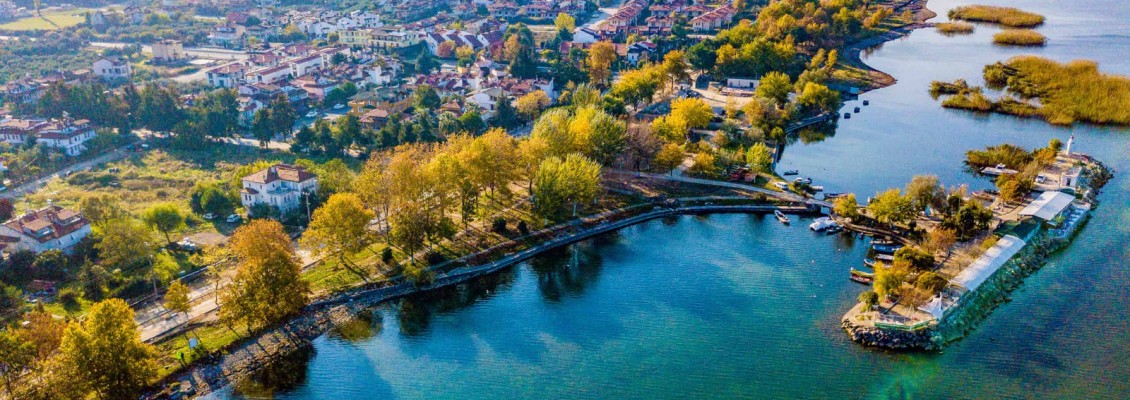
İZNİK
İznik is a historical and culturally rich district in Türkiye’s Bursa province. Known in ancient times as Nicaea, İznik has witnessed the rise and fall of major empires, leaving behind a heritage that continues to charm visitors. Its historical significance, combined with its natural beauty and vibrant cultural heritage, makes it a must-visit destination.
İznik was founded in the 4th century BCE by Antigonus, one of Alexander the Great’s generals. Later, it was renamed Nicaea by another general, Lysimachus. Under Roman and Byzantine rule, İznik became a vital cultural and religious centre. Two important Ecumenical Councils, The First Council of Nicaea (325 CE) and The Seventh Ecumenical Council (787 CE), took place in İznik.
The Seljuks made the city their capital for a brief period in the 11th century, leaving their mark on its history and architecture. In the 13th century, Byzantine emperors-in-exile also used İznik as their capital after Constantinople fell to the Crusaders. The Ottomans captured İznik in 1331, marking a new era. The city became renowned for its production of vibrant, hand-painted tiles, a tradition that continues to captivate the world. Tiles produced in İznik were used in many places such as mosques, masjids, madrasahs, soup kitchens, baths, palaces, mansions, public fountains and libraries. The most beautiful examples of İznik tiles can be found in the SultanAhmet Mosques, which is also now known as The Blue Mosque because of its marvelous blue tiles.
İznik Hagia Sophia Mosque (Orhan Mosque)
Hagia Sophia of İznik was first built in the 4th century, but it was rebuilt on the ruins by Justinian in the 6th century. However, this was not the only time that was rebuilt. The building was almost completely destroyed in the great earthquake of 1065; therefore, it was rebuilt once more. When the Ottomans conquered İznik in 1331, Sultan Orhan Gazi converted the church into a mosque, showcasing the seamless blending of Byzantine and Ottoman architectural styles.
Lefke Gate
The Lefke Gate is one of the main gates of the ancient city walls of İznik. It dates back to the Roman and Byzantine periods and was part of the defensive structure that protected the city. The gate is an important historical site and offers a glimpse into the city’s past as a fortified settlement. It is located on the western side of the town and is still well-preserved, giving visitors the chance to see the original architecture and design.
Bursa Iznik Nilüfer Hatun Imaret Turkish Islamic Arts Museum
The Nilüfer Hatun Imaret, now home to the Turkish Islamic Arts Museum in İznik, is an Ottoman-era building that originally served as a soup kitchen and a charitable institution. It was established by Nilüfer Hatun, the wife of the Seljuk ruler Çandarlı Kara Halil Pasha, in the 14th century.Today, the museum showcases a variety of important Turkish Islamic art pieces, with a special focus on the famous Iznik ceramics. Visitors can explore a collection of tiles, pottery, calligraphy, and textiles, offering insight into the rich artistic traditions of the Ottoman period and the city's contribution to Islamic art.
The Green Mosque
The Green Mosque was built in 1378 by Çandarlı Halil Hayrettin Paşa and it is one of the most important architectural landmarks in the town. The mosque is renowned for its beautiful turquoise and green İznik tiles that decorate its walls and minaret, giving it its name.
Ancient Theatre of Nicaea
The Ancient Theatre of Nicaea is an archaeological site in İznik that dates back to the Roman period. Built in the 2nd century CE, the theatre could once hold up to 20,000 spectators and was used for various performances, including theatrical plays and gladiatorial contests.
Although much of the theatre is in ruins today, visitors can still see the remnants of the seating area, stage, and part of the orchestra. The structure was originally designed in the traditional Roman style, with a semi-circular seating arrangement and a central stage.
İznik Tile Workshops
İznik’s iconic ceramic tiles are still made in traditional workshops, where artisans create vibrant, hand-painted designs. Visitors to the İznik Tile Workshops can watch skilled artisans create tiles by hand, using traditional methods passed down through generations. It’s also a great place to purchase authentic İznik ceramics, from small decorative pieces to large tiles that showcase the intricate craftsmanship.

Leave a Comment